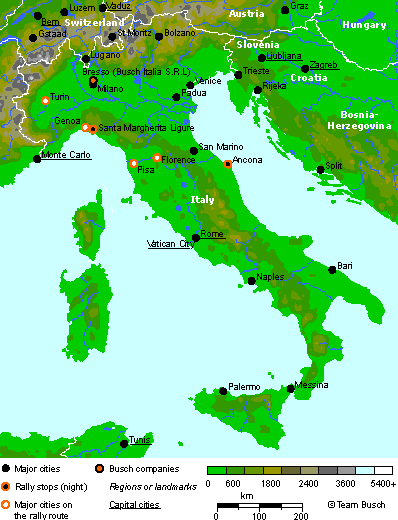|
||||||||||||||||
 |
||||||||||||||||
|
|
Italy Repubblica ItalianaArea: 301,230 sq km Climate: predominantly Mediterranean; Alpine in far north; hot, dry in south Terrain: mostly rugged and mountainous; some plains, coastal lowlands Elevation extremes: lowest point: Mediterranean Sea 0 m highest point: Mont Blanc (Monte Bianco) 4,807 m Geography—note: strategic location dominating central Mediterranean as well as southern sea and air approaches to Western Europe Population: 56,735,130 (July 1999 est.) Ethnic groups: Italian (includes small clusters of German-, French-, and Slovene-Italians in the north and Albanian-Italians and Greek-Italians in the south) Religions: Roman Catholic 98%, other 2% Languages: Italian, German (parts of Trentino-Alto Adige region are predominantly German speaking), French (small French-speaking minority in Valle d'Aosta region), Slovene (Slovene-speaking minority in the Trieste-Gorizia area) |
 |
|
Two famous Italian-born gentlemen can be related to our adventure: Christopher Columbus (1451-1506), born in Genoa, who re-discovered the "New World" of the Americas (1492) for the Spanish and for the whole of Europe. He only touched North America, though, (visiting Mexico) and spent most of his time on a ship. Marco Polo (1254-1324), a Venice merchant, who did not discover any new worlds but through his vivid accounts of his travels to China (1271-1295) made the "West" aware of the cultural, technological and literal riches of the "East". His journey, in fact, coincides with many parts of our journey: Trabzon, Samarqand, Kashgar, the Takla Makan, the routes of today have not changed much over the generations. www.britannica.com provides an overview of his route. Route notes of the rally: …coming from France. Wednesday 3rd May - Day 3 — Aix les Bains to Santa Margherita 500km The Alps lie ahead, but at this time of year the only way into Italy is under them! Fast roads take you to the Frejus Tunnel before a loop of mountain roads take us to a control in the shadow of one of the largest fortresses that you have ever seen. The broad valley of the River Po is crossed on fast back roads before some testing sections into the Ligurian Hills. Finally, the Mediterranean coast is reached near Genoa and it is an easy Autostrada run to the pretty Italian seaside town of Santa Margherita. Thursday 4th May - Day 4 — Santa Margherita to Ancona 545km Another early start heralds another long day crossing Italy. The first section south to Pisa (yes, you can see the Leaning Tower as you flash by!) is again on fast Autostrada and main roads but soon the beautiful Tuscan Hills lie ahead and the first gravel roads of the rally. The vineyards and sleepy villages of Chianti follow as you work your way across the Apennines, followed by even more spectacular scenery as you head south towards the Adriatic, Ancona and our specially chartered Superfast ferry overnight to Greece. …moving on to Greece. |